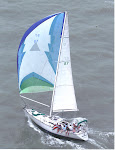I have never seen a boat with two sets of bow cleats (four total). After years of cruising I do not understand why this is not standard. At a rough anchorage with two anchors down the chain or rode needs a cleat on each side as does each snubber. At dock a bow line and a spring line each need a cleat. When not in use each anchor has a safety line that needs to be secured. When hurricanes threaten each point of the boat needs to be secured with a loose line and a very loose line. There is an old sailing maxim that only one line should be on a cleat. There are then numerous precautionary tales about disaster that occurs when too many lines were attached to a single cleat. So why do sailing yachts only have two cleats on the bow?
White Pepper chose to add a second set of cleats recently. I called South Shore Yachts in Canada which supplies parts for old C&Cs. They said the original cleats were generics from a Taiwan source now out of business. I found a very close match with Schaefer Marine in the 8 inch open style bolted down with four 5/16 bolts. Grainger.com sent the stainless steel 5/16-18 x 3 and 1/2 inch bolts and nuts. West Marine supplied the washers. Flour Bluff Plastics made the Starboard pieces back in Texas. Cesany Plastics, Inc helped with some last minute additional parts online. By the way these guys at Cesany are great, and I can highly recommend them for any plastics work. Finally everything was assembled.
One of the best and worst parts of the C&C 41 is the toe rail. It is incredibly versatile. However, it runs all the way to the bow. In a windy anchorage I am sure that the toe rail could saw right though any line. My solution was to fashion a platform of Starboard an inch and half high and level with the toe rail. This will allow the line to go straight from the cleat into the water--an air chock! No friction, no sawing action, no need for chafe protection! I got the idea from Heinz' book on anchoring, The Complete Book of Anchoring, now out of print, I believe. As an added benefit I have learned how to lead the standing end (the part that goes to the load, i.e. the anchor) over the top of the cleat allowing for even more clearance.
It was all assembled today. I am sure that the new arrangement will be safer, more secure, and allow for more restful sleep below during a blow at anchor.
White Pepper chose to add a second set of cleats recently. I called South Shore Yachts in Canada which supplies parts for old C&Cs. They said the original cleats were generics from a Taiwan source now out of business. I found a very close match with Schaefer Marine in the 8 inch open style bolted down with four 5/16 bolts. Grainger.com sent the stainless steel 5/16-18 x 3 and 1/2 inch bolts and nuts. West Marine supplied the washers. Flour Bluff Plastics made the Starboard pieces back in Texas. Cesany Plastics, Inc helped with some last minute additional parts online. By the way these guys at Cesany are great, and I can highly recommend them for any plastics work. Finally everything was assembled.
New second bow cleat on starboard and on top of 1.5 in of Starboard
Original cleat on port on right and new one to left.
Karl's version of the cleat knot. Note the standing end leads over the top. An air chock!
Beautiful Hibiscus





No comments:
Post a Comment